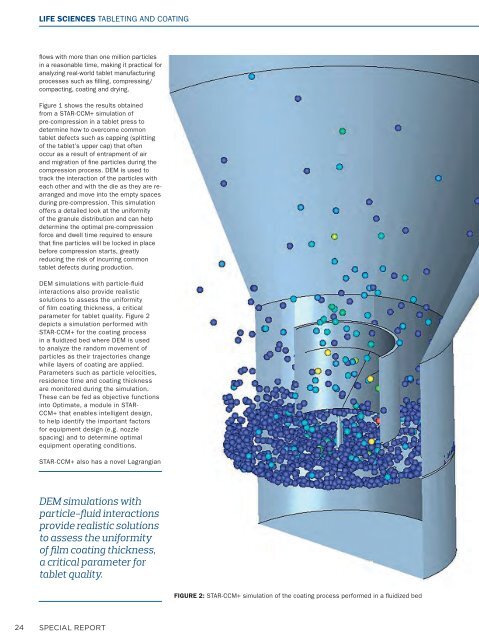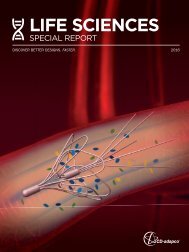Life science special report 161215 IY opt
Create successful ePaper yourself
Turn your PDF publications into a flip-book with our unique Google optimized e-Paper software.
LIFE SCIENCES TABLETING AND COATING<br />
flows with more than one million particles<br />
in a reasonable time, making it practical for<br />
analyzing real-world tablet manufacturing<br />
processes such as filling, compressing/<br />
compacting, coating and drying.<br />
Figure 1 shows the results obtained<br />
from a STAR-CCM+ simulation of<br />
pre-compression in a tablet press to<br />
determine how to overcome common<br />
tablet defects such as capping (splitting<br />
of the tablet’s upper cap) that often<br />
occur as a result of entrapment of air<br />
and migration of fine particles during the<br />
compression process. DEM is used to<br />
track the interaction of the particles with<br />
each other and with the die as they are rearranged<br />
and move into the empty spaces<br />
during pre-compression. This simulation<br />
offers a detailed look at the uniformity<br />
of the granule distribution and can help<br />
determine the <strong>opt</strong>imal pre-compression<br />
force and dwell time required to ensure<br />
that fine particles will be locked in place<br />
before compression starts, greatly<br />
reducing the risk of incurring common<br />
tablet defects during production.<br />
DEM simulations with particle-fluid<br />
interactions also provide realistic<br />
solutions to assess the uniformity<br />
of film coating thickness, a critical<br />
parameter for tablet quality. Figure 2<br />
depicts a simulation performed with<br />
STAR-CCM+ for the coating process<br />
in a fluidized bed where DEM is used<br />
to analyze the random movement of<br />
particles as their trajectories change<br />
while layers of coating are applied.<br />
Parameters such as particle velocities,<br />
residence time and coating thickness<br />
are monitored during the simulation.<br />
These can be fed as objective functions<br />
into Optimate, a module in STAR-<br />
CCM+ that enables intelligent design,<br />
to help identify the important factors<br />
for equipment design (e.g. nozzle<br />
spacing) and to determine <strong>opt</strong>imal<br />
equipment operating conditions.<br />
STAR-CCM+ also has a novel Lagrangian<br />
DEM simulations with<br />
particle-fluid interactions<br />
provide realistic solutions<br />
to assess the uniformity<br />
of film coating thickness,<br />
a critical parameter for<br />
tablet quality.<br />
FIGURE 2: STAR-CCM+ simulation of the coating process performed in a fluidized bed<br />
24 SPECIAL REPORT



